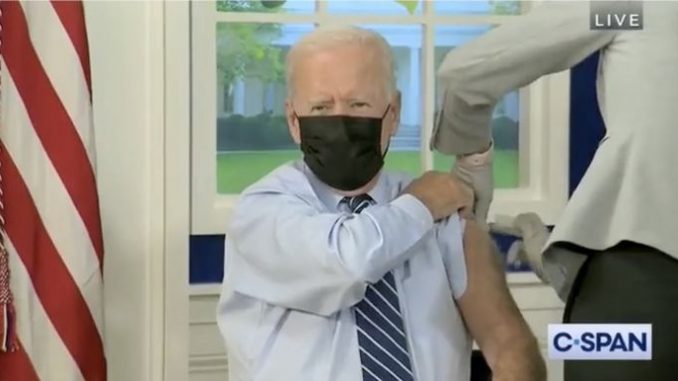
Joe, I have bad news.

According to the NYT, at the current average daily rate of vaccination in the U.S., it’ll take us nine more months to hit 85 percent with a first dose:

The fact that kids under 12 will soon be eligible means, on the one hand, that we might get to 85 percent sooner as a new segment of the willing population presents their arms for shots. On the other hand, we’re gradually running out of adults in the “wait and see” group and running up against hardcore anti-vaxxers, which means the pace among adults should get slower and slower over time. And the share of parents willing to let their young children get immunized knowing how low the risk is that they’ll get severely ill if they aren’t may be much smaller than we think.
We may top out at — what? Seventy-five percent? Higher? Lower?
I don’t know what Biden’s thinking in floating this number, which he offered during a brief Q&A following his booster shot this afternoon. I’ve never heard a scientist speculate that we’ll get anywhere near 100 percent vaccinated. Even the hard-asses in the Australian government are setting 80 percent as their target for easing restrictions. Watch, then read on:
REPORTER: "How many Americans need to be vaccinated for us to get back to normal?"
BIDEN: "97%, 98%. I think we'll get awful close. But I'm not the scientist. I think one thing is for certain. A quarter of the country can't go unvaccinated and us not continue to have a problem." pic.twitter.com/oT0zRXxpJo
— Townhall.com (@townhallcom) September 27, 2021
One: He’s mixing up immunity with vaccination. It certainly is possible that we’ll reach 97 or 98 percent of the population with antibodies against COVID. In fact, over a long enough timeline, I guarantee it. But some meaningful portion of that number will acquire their antibodies the old-fashioned way, through infection. Biden rarely seems to account for them in his thinking on the pandemic — his federal vaccine mandate contains no exception for those who are naturally immune — but maybe he’s thinking of them here. Upwards of 100 percent of Americans will have immunity eventually. Conceivably, due to the rapid spread of Delta, we could reach that level sooner than we think.
Two: He’s grossly overestimating how effective his new mandate will be in convincing holdouts to get their shots. You’ll notice in the clip that he mentions how successful some schools have been in convincing students to get vaccinated, and that’s true. New numbers from Yale find that 99.2 percent of undergrads have had their shots. But a university is a community of thousands, not hundreds of millions, and Americans are used to complying with vaccine mandates as a condition of attending school. A broad, legally dubious vaccine mandate for the entire share of the labor force that’s employed at businesses with 100 or more workers is an entirely different ballgame. It’s not even a true mandate since Biden offered the unvaccinated the option to get tested regularly in lieu of being immunized.
Dogged vaccine resisters will submit to a weekly test instead (I know someone personally who’s doing that) and resisters who work at smaller businesses will continue on as usual. The mandate may add a few percentage points to the share of the population that’s had a first dose but Biden’s even more addled than we thought if he thinks the number of vaccinated will skyrocket.
After all, vaccinating 95+ percent of the population would be challenging even for a dictatorship. For a western country like America, with its current stew of cultural pathologies, it’s laughably impossible.
America’s historical contrarianism about vaccines has many potential sources. Uninsured people who can’t afford to see doctors may be conditioned to trust in their body and hope for the best. A history of medical racism has coincided with lower trust for novel treatments among Black Americans. But not all American vaccine skeptics suffer from discrimination or a lack of resources. Perhaps a country whose laws and culture celebrate independence of thought might naturally yield a bimodal distribution of contrarians: lots of paradigm-breaking entrepreneurs and scientists on one side, and lots of conspiratorial cranks on the other.
That leads to the second part of Petersen’s explanation: America’s vaccine attitudes are unusually politicized. “The level of polarization between Democratic and Republican elites seems unique to me,” Petersen said, “and it’s a leading factor in why American vaccination rates are relatively low.”
The U.S. is distinctly unlucky in having a polarized two-party system, in which one party’s elites take up vaccine resistance as a prominent cause. While GOP governors and even former President Donald Trump have admitted to being vaccinated and occasionally recommended the shots, the party’s most significant media organs, including Fox News, have consistently questioned the benefits of the vaccines, amplified the side effects, celebrated evidence-free skepticism, and blasted attempts to promote vaccinations. Today, Florida Republicans aren’t just claiming that the vaccines are faulty. They’re reportedly looking to rescind measles- and mumps-vaccine requirements. Negative polarization has fully overtaken the right wing of the Republican Party, whose ethos is now something like “Whatever liberals say, I’m against” and whose members stand ready to embrace the most absurd conclusions of that logic.
It was just last week that one populist writer tried to reason his readers into getting vaccinated by accusing Democrats of endorsing the vaccines knowing that conservatives would resist per “whatever liberals say, I’m against” illogic. The only way to truly own the libs, in other words, was to refuse to fall for their reverse psychology and get the shots. That any part of the country might need spite as a motivation to protect themselves from a deadly disease is a sign that America is ill with more than just COVID, but whatever reasoning works to increase uptake is for the best. As long as we all realize we’ll never get close to 97-98 percent.
Via Hot Air
